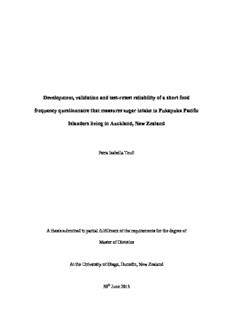
Development, validation and test-retest reliability of a short food frequency questionnaire that ... PDF
Preview Development, validation and test-retest reliability of a short food frequency questionnaire that ...
Development, validation and test-retest reliability of a short food frequency questionnaire that measures sugar intake in Pukapuka Pacific Islanders living in Auckland, New Zealand Petra Isabella Teufl A thesis submitted in partial fulfillment of the requirements for the degree of Master of Dietetics At the University of Otago, Dunedin, New Zealand 30th June 2013 ! Abstract( Background: Sugar intakes have increased worldwide in parallel with the obesity, diabetes and cardiovascular disease epidemics indicating that sugar may be partly responsible. In New Zealand (NZ) the prevalence of these conditions are higher in the Pacific Island population than in the general population. Thus there is a need to develop a valid and reliable instrument to measure sugar intakes to establish whether high sugars intake, particularly fructose, are associated with chronic disease risk. The food frequency questionnaire (FFQ) is a relatively quick, simple and cost effective method to measure food and beverage consumption in large epidemiological studies. Objective: The present study aimed to develop, pretest and conduct a preliminary investigation into the validity and test-retest reliability of a 33-item, open-ended, self- administered, semi-quantitative food frequency questionnaire (FFQ) designed to measure usual sugars intakes over the previous month in Pukapuka Pacific Islanders living in South Auckland, NZ. Design: Two versions of the FFQ (open- and closed-ended) were pretested among a sample of ten Pacific Island adults living in South Auckland using cognitive interviews. Minor amendments were made to the preferred open-ended format prior to validation. Thirty-three Pukapuka Pacific Islanders, aged 18-59 years, then completed the final Pukapukan Kai FFQ administered on two occasions three weeks apart to assess test-retest reliability. The relative validity of the FFQ was assessed by comparing the data from the second administration of the FFQ (FFQ2) to the mean of three 24-hour (24h) recalls ! !ii! ! collected over three weeks prior to FFQ2. Validation was assessed using paired t-tests, Bland-Altman analysis, cross-classification, the weighted kappa and spearman correlations (SC). Differences in the mean between FFQ administrations and intraclass correlation coefficients (ICCs) were used to assess the reliability of the FFQ. Results: The FFQ adequately estimated the group’s geometric mean intake of fructose, glucose and total sugars (but not sucrose, P<0.05) over the previous month compared to the reference method. According to the Bland-Altman analysis, the mean percentage of agreement ranged from 97 for fructose to 125 for sucrose. However, the limits of agreement (LoA) were wide. Classification into the same or adjacent quartile ranged from 82% for fructose to 91% for sucrose and weighted kappas were at least 0.47 for all sugars. Spearman correlations ranged from 0.62 for glucose to 0.77 for total sugars. The ICCs between FFQ administrations ranged from 0.58 to 0.73 indicating good test-retest reliability. Conclusion: This study provides initial evidence that the FFQ has the capability to adequately estimate a group’s usual mean intake of fructose, glucose and total sugars over the previous month, but not sucrose. It can also rank a group of individuals according to their sugars intake and as a result can be used in large-scale epidemiological studies to examine the association between sugar intakes and chronic diseases in Pukapuka Pacific Island adults. Similar to other FFQs, this instrument lacks precision to estimate an individual’s precise sugars intake and is unsuitable for use in clinical practice. Further validation and reliability testing, using biomarkers of intake, among a larger sample of a wider range of Pacific Island people would be beneficial. ! i!ii! ! Keywords: Food frequency questionnaires; Sugar; Validity; Reliability; Pukapuka Pacific Island adults! ! i!v! ! ! Preface( This MDiet project is a part of a larger study that aims to validate a short food frequency questionnaire (FFQ) to measure sugar intakes in Pukapuka Pacific Islanders living in South Auckland, New Zealand (NZ). The FFQ used in this research went through several iterations during its development in January and February 2013. An academic staff member designed the original closed-ended version of the FFQ with inspiration from several sources (Section 4.1.1) In February 2013 the student pretested both the closed- and open-ended versions of the FFQ among a sample of ten Pacific Islanders living in NZ. Participants preferred the open- ended format of the FFQ, which was then modified to include additional sugar-containing foods and beverages commonly consumed by Pukapuka Pacific Islanders living in South Auckland, additional photos of food items and amounts, and other minor wording and format changes to improve readability and comprehension of the task. The questionnaire was finalised as a 33-item, open-ended, self-administered, semi- quantitative FFQ. From March 2013 the evaluation study began which consisted of each participant completing the same self-administered FFQ twice (three weeks apart) to assess the test-retest reliability of the FFQ and three 24h recalls to test the relative validity of the ! !v! !
Description: